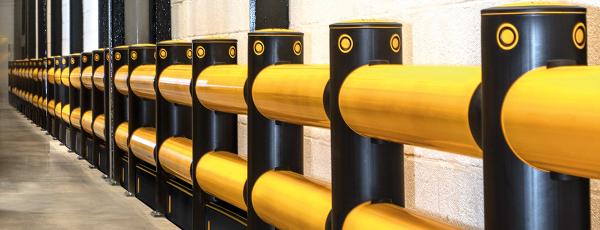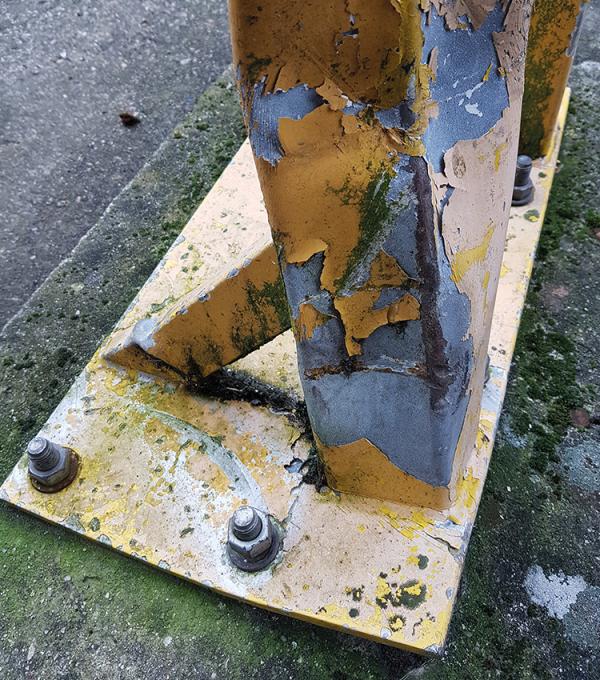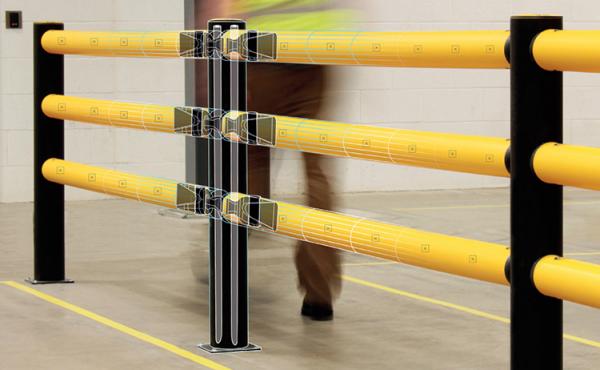Can plastic safety barriers really match metal structures in protecting against forklift truck collisions? With the right materials, design and technology, yes, they can. What’s more, their flexible solutions offer important advantages over traditional solid defences. In the March edition of Eureka, the online magazine for the materials handling professional, Mark Nicholson reported on this interesting health and safety topic. Here’s an abridged version of the article.
When the power, speed and sheer weight of a forklift truck are misdirected, their potential impact on people, equipment and buildings is huge. Not surprisingly, warehouse safety designers have tended to rely on the strength of metal for protection often taking the form of steel crash barriers, railings and bollards, with bases either bolted to the floor or set within the concrete itself.
Metal’s ongoing costs
Although undoubtedly effective, metal has side-effects which need considering when weighing up the long-term costs of different warehouse safety barrier options. These include:
- The way metal reflects and transmits impact forces. Relatively inflexible, metal crash barriers direct much of the collision shock straight back into the colliding vehicle and in most cases, this will result in substantial damage. A forklift may suffer some damage, but due to its more robust nature it is more likely to pass the shock on to its driver and load. This could lead to whiplash injury or a heavy fall for the driver, and damage to goods thrown from the forks.
- How force is transmitted through the barrier and into the floor. In the heaviest collisions, that force is enough to break the concrete – which is expensive to repair. Less serious incidents may just dent or bend the metal, which is also costly, so bent and twisted but still functional metal is sometimes left unrepaired.
- Metal barriers don’t keep their looks. Neat and tidy when new, but scratched and worn paint, rust and accident damage soon spoil the safety barriers. Therefore, regular spend will be needed to maintain them.
Plastic’s flexible benefits
The best plastic safety barriers are designed to absorb and dissipate shocks. Absorption is achieved partly through plastic materials which deform temporarily under impact and then return to their original shape. They also have additional components which flex or cushion in response to impacts. Meanwhile, their whole system works together to disperse impact energy harmlessly over large areas.
Vehicles, drivers, goods, and floors escape damage, and so do the plastic safety barriers, provided the right specification is chosen. There is no need to paint or repaint, and no rusting. What’s more, they are comparatively easy to relocate if premises are restructured.
The market offers an extensive choice of flexible plastic safety barriers meeting all needs. Key categories include crash barriers, handrails, bollards and racking protection.
There are many technologies available on the market today and some of the top manufacturers for plastic safety barriers include A-SAFE, Boplan and McCue. Each of these manufacturers offers modular systems covering a range of barrier types and with variations to suit every specific situation. Their safety barriers whilst using differing technologies, match metal in strength but are flexible, and designed to absorb shocks and dissipate them through the body of the barrier.
Although some plastic safety barrier systems may be higher-priced than their metal counterparts, warehouse operators must always think in terms of total cost of ownership for warehouse safety. When adding up the costs of metal barrier and concrete floor replacement or repair after each accident, plastic may become more economical. You should also look at how much routine maintenance they will need. Then factor in the damage and injury that metal barriers may do to forklifts, goods and drivers, and the time lost as a result.
Train drivers to drive carefully
Remember that collisions are caused by poor driving therefore the first line of defence to avoid accidents should be to train drivers well and enforce a strong warehouse safety policy. Safety barriers need to be effective, but the aim must be to avoid hitting them in the first place.
Driver error can be reduced by advances in precision steering, controlled operation and automated safety, as found on the award-winning Cat® EP14-20A(C)N(T) electric counterbalance forklift truck. Nevertheless, strict safety rules, thorough training and effective warehouse safety barriers are still vital to minimising risks of collision injury and damage in the workplace.
To read the unabridged version and find out more information on the technologies used by the market leaders in creating plastic safety barriers, read the March article from Eureka magazine here.


